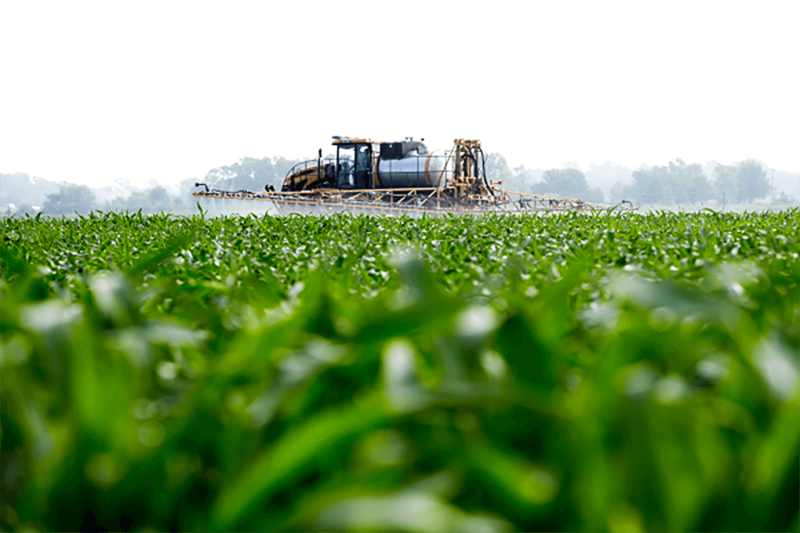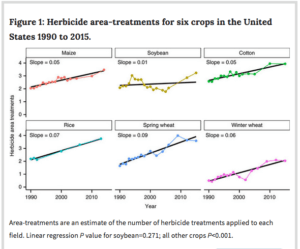This is the second in a three-part series making the case that the development of the biotech traits for insect resistance and herbicide tolerance are the most substantial innovations in sustainable agriculture in the last three decades. In part one, I laid out the context in which I believe they should be assessed relative to other innovations competing for the crown. In this part, I examine the data and evidence of their overall environmental impacts. In the final installment, I’ll make my closing argument after looking at the impacts on China, India, Pakistan and South Africa.
Every year, the agricultural and natural resources industry consulting firm updates their magisterial literature review and data analysis [PDF] on the global impacts of GE crops. It takes the peer reviewed research literature and public data pulls it into a systematic attempt at quantification. I’ve asked people I respect about the quality of this work. And no one I’ve talked to has found any reason to see the effort as flawed, nor have I come across any written critiques anywhere. I find the report to be transparent, well sourced, and forthright about methodology and the limitations of their methods. Some of these are based on complex calculations with wide margin for error. But even taken as back-of-the-envelope math (and it’s far more sophisticated than that), they lay out the scale of these impacts and define the bar if you want to put forth some other innovations as having had greater impact.
Among their findings:
- Globally, permanent savings in carbon dioxide emissions (arising from reduced fuel use of 9,823 million litres of fuel) since 1996 have been about 26,221 million kg, with the additional amount of soil carbon sequestered since 1996 has been equivalent to 227,208 million kg of carbon dioxide that has not been released into the global atmosphere.
- In the US the combined numbers for corn and soy are a savings of 2.8 billion litres of fuel from 1996-2015 and 72 billion kg of carbon emission sequestered or saved in reduced fuel burning.
- In South America the numbers are even more dramatic. The combined fuel savings has been 5.8 billion litres of fuel and the combined carbon savings 166 billion kg.To put some of these numbers in perspective, they looked the carbon savings from 2015, the last year they had data from and found it the fuel savings “was the equivalent of removing 1.25 million cars from the road for a year and the additional soil carbon sequestration gains (23,900 million kg carbon dioxide) were equivalent to removing 10.62 million cars from the roads. In total, biotech crop-related carbon dioxide emission savings in 2015 were equal to the removal from the roads of 11.88 million cars, equal to 41% of all registered cars in the UK.’
- Since 1996, the use of pesticides on the GE crop area was reduced by 618.7 million kg of active ingredient (8.1% reduction), and the environmental impact associated with herbicide and insecticide use on these crops, as measured by the Environmental Impact Quotient (EIQ) indicator, fell by 18.6%. (Let me note that EIQ is a very rough and potentially problematic measure of environmental impacts, especially for herbicides, but also across so many variables on a gigantic dataset. At best it should be taken as a sign that across a range of measures, on balance toxicity fell. That doesn’t mean that toxicity didn’t rise on some measures in troubling ways and was cancelled out by other large improvements on what might be less salient variables. Take it with a grain of salt. I’ll share some more granular measures by weed scientist Andrew Kniss a little further down.)
- In US cotton they find the Bt trait resulted in in an annual saving in the volume of insecticide ai use of 63.5% in 2015 (2.5 million kg) and the annual field EIQ load on the US cotton crop also fell by 27.5% in 2015 (equal to 53 million field EIQ/ha units). Since 1996, the cumulative decrease in insecticide ai use has been 24.9% (19.5 million kg), and the cumulative reduction in the field EIQ load has been 19.6%
- In Bt corn, globally, they find a 53% (87 million kg) cumulative reduction in active ingredient and a reduction of 7.8 million kg for 2015 alone, amounting an 84% reduction for that year.
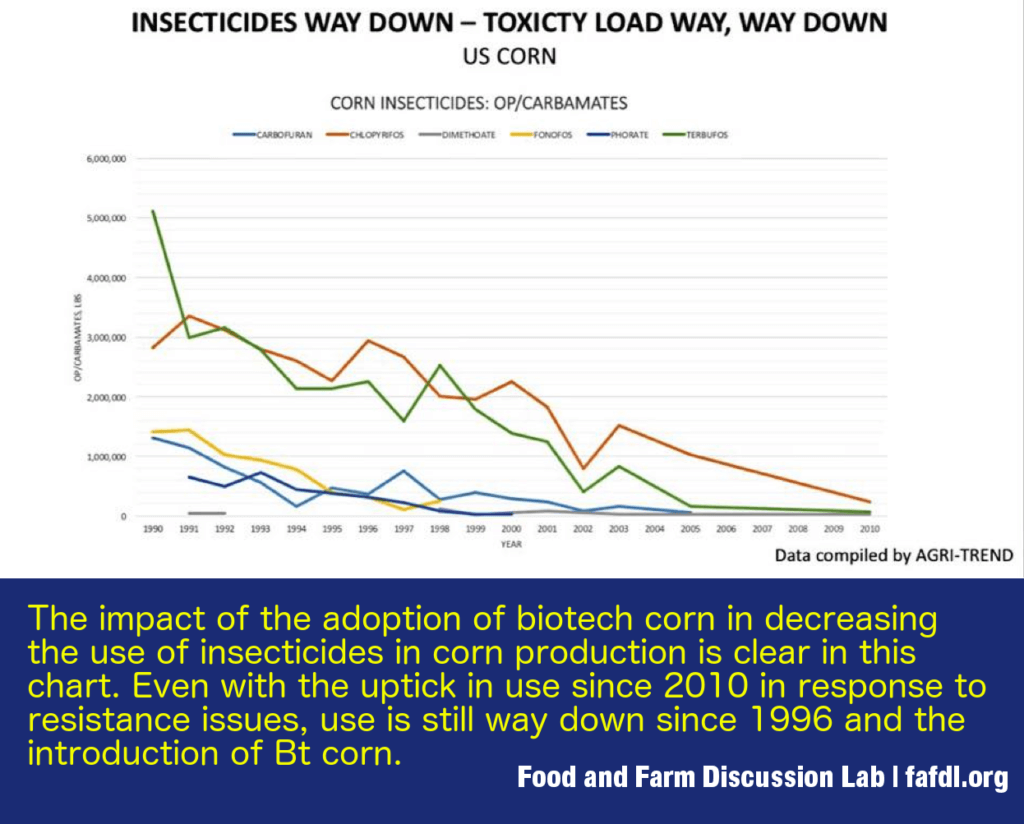
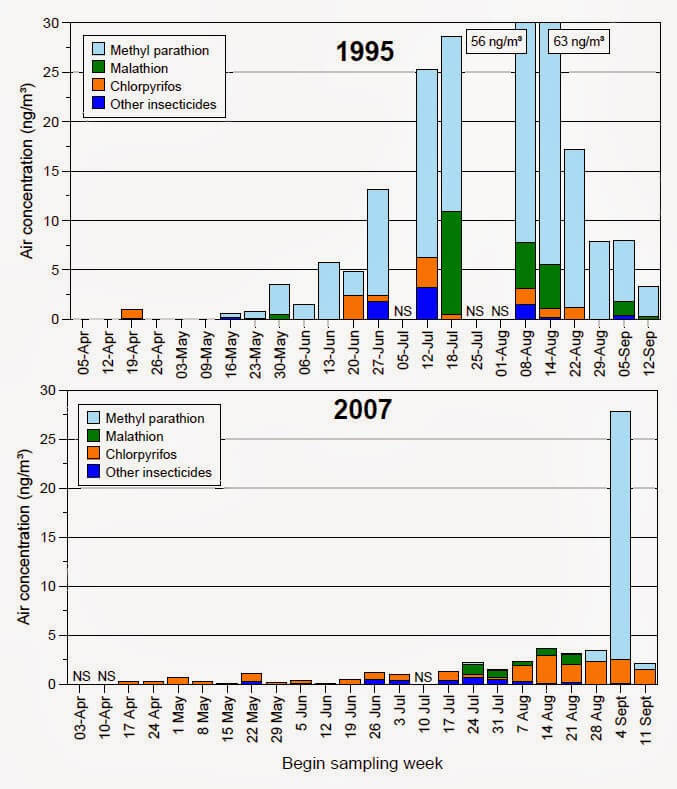
Farmer income
In the interest of space, we’ll just look at the example of Argentina, a non-wealthy nation that bounces in and out of official “emerging market status”. From a development perspective, increasing farm incomes there is a big deal.
In Argentina, Brookes and Barfoot found savings from reduced expenditure on herbicides, fewer spray runs and machinery use have been in the range of $24-$30/ha (hectare), although since 2008, savings fell back to $16-$26/ha because of the significant increase in the price of glyphosate relative to other herbicides in 2008-09 and additional expenditure on complementary herbicide use to address weed resistance (to glyphosate) issues. Net income gains have been in the range of $21-$29/ha up to 2007 and $14-$24/ha since 2008. The net income gain from use of the Roundup Ready technology at a national level was $448 million in 2015. Since 1996, the cumulative benefit (in nominal terms) has been $6 billion.
An interesting wrinkle is that part of the gains for Argentine farmers is that Roundup Ready soybeans have allowed many of them to grow soy as a second crop after wheat harvest. The time freed up by the reduction in tillage practices allows for that second crop. Nearly 20% of the Argentine soybean crop came from wheat farmers supplementing their annual income in 2015, up from 8% in 1996. The represented a $484 million boost to national farm income in 2015 and $11 billion cumulatively since 1996.
What does other research show?
I want to look at two other areas before wrapping up. The first is sorting out the complicated picture on the impact of Roundup Ready and other herbicide-tolerant crops on environmental impacts. Then we’ll take a look at Bt cotton in India, Pakistan, and China.
Environmental Impacts of RoundUp Ready Crops
The researcher who has looked at the environmental questions most vexing the public debate is Andrew Kniss, a professor of weed science at the University of Wyoming. In 2017 he published “Long-term trends in the intensity and relative toxicity of herbicide use.” and Genetically Engineered Herbicide-Resistant Crops and Herbicide-Resistant Weed Evolution in the United States earlier this year.
The 2017 paper attempts to suss out the question of what has happened to herbicide use on major crops over the last two decades: Has use increased or decreased, have environmental impacts increased or decreased, and what role the RoundUp Ready traits have had on those changes? In a blog post on the publication of the paper, Kniss summarized his findings.
First of all, I found strong evidence that herbicide use has indeed increased in GMO crops (corn, soybean, and cotton), much as the critics have suggested. However, I also found that herbicide use has increased even faster in the non-GMO crops rice and wheat. This suggests that there is an overall trend for increasing herbicide use in all crops, irrespective of whether GMO varieties are available. It is even plausible, based on these data, that GMO crops have slowed the increase in herbicide use (though it is impossible to say for sure).
Another interesting finding from this analysis is that the trends in relative herbicide toxicity are different depending on whether you look at acute or chronic toxicity. Acute toxicity is what most people think of when they hear the word “toxic.” Acute toxicity describes how much of a chemical would be required to cause problems in a one-time exposure. Think spilling onto your clothes, or accidentally drinking the herbicide. But for pesticide applicators, the chronic toxicity of a herbicide is arguably more relevant, since they’re interacting with these chemicals on a regular basis for many years of their lives. It is rare for an applicator to accidentally ingest an acutely toxic dose; but much lower doses are required to cause chronic effects, as long as the exposure is repeated enough times. As a pesticide applicator myself, I was particularly interested in the chronic toxicity hazard results.
Of the three GMO crops in the analysis, the chronic toxicity hazard associated with herbicides has actually increased in corn and cotton, but decreased in soybean over the last 25 years. But in all three crops, few of the changes in herbicide use that caused chronic toxicity to change are directly attributable to the GMO traits. In the final year of corn herbicide use data (2014), just two herbicides (atrazine and mesotrione) made up 88% of the total chronic toxicity hazard. In cotton, just one herbicide (diuron) made up 88% of the total chronic toxicity hazard. Use of these herbicides aren’t tied to adoption of GMO crops; these herbicides were used before GMOs, and have continued to be used after GMO adoption.
Even though glyphosate use has increased greatly over the last 25 years, my analysis suggests the relative contribution of glyphosate to the chronic toxicity hazard has remained relatively low. Glyphosate has a very low chronic toxicity compared to most other herbicides. In corn and cotton, the chronic toxicity hazard increased over the last 25 years, but glyphosate contributed less than 4% to the chronic toxicity hazard in the final year of the data set. Similar results were observed in soybean, where glyphosate accounted for 43% of all herbicide treatments in 2015, but glyphosate made up less than 1% of the chronic toxicity hazard.
Another interesting finding in this paper is that most of the major reductions in toxicity hazard were unrelated to the adoption of GMO crops. Where toxicity was reduced, it was mostly due to EPA removing the most toxic herbicides from commercial use. In particular, registration cancellations for cyanazine, alachlor, and molinate had major impacts on the toxicity hazard quotients in the analysis .
The short version: Yes, herbicide use increased as a general trend, but the increase was higher in major non-GE crops like wheat and rice than it was in corn and soybeans. In terms of toxicity, the substitution of glyphosate for other herbicides significantly lowered the toxicity profile of herbicide use in the US, even as the amount of active ingredient increased. That looks like this in corn – total pounds, down slightly, toxicity way down:

And like this in soybeans – pounds per acre up, toxicity down, though ticking up as glyphosate resistant pigweed became a problem in soybean production:
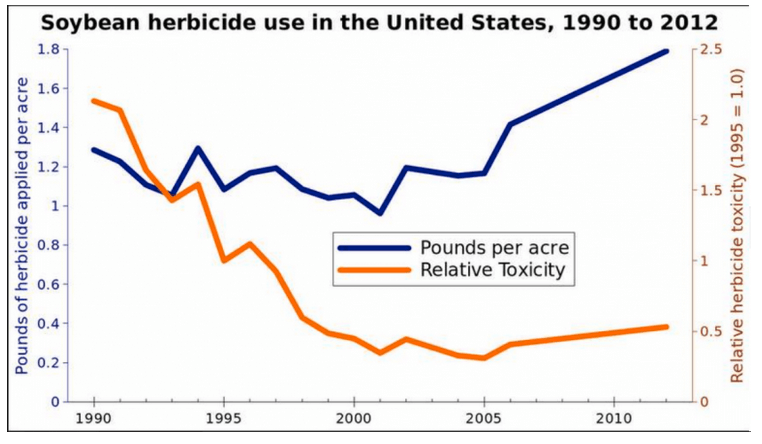
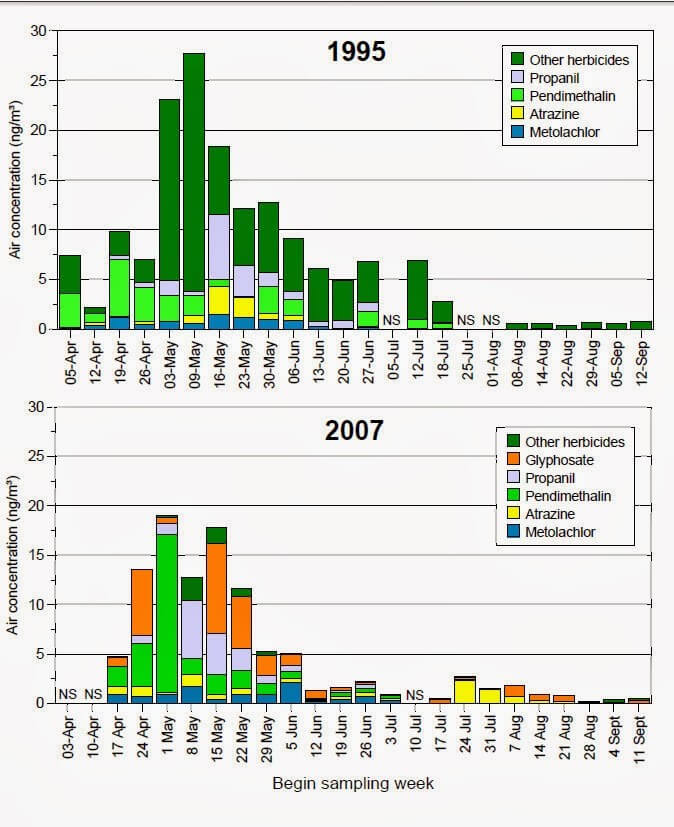
And to return to a point raised earlier — one that bears repeating for our friends who haven’t internalized it yet — those reductions in insecticide use and herbicide toxicity are happening on nearly 90 million acres of corn and 76 million acres of soybeans in the US.
What about “superweeds”?
Before we get to Kniss’ paper, let me humbly recommend the primer on “superweeds” I did for GLP a few years back.
The methods and the results of the 2018 paper are laid out very clearly in the abstract of the paper:
Here, I analyze data from the International Survey of Herbicide Resistant Weeds and the USDA and demonstrate that adoption of GE corn varieties did not reduce herbicide diversity, and therefore likely did not increase selection pressure for herbicide resistant weeds in that crop.
Adoption of GE herbicide-resistant varieties substantially reduced herbicide diversity in cotton and soybean. Increased glyphosate use in cotton and soybean largely displaced herbicides that are more likely to select for herbicide-resistant weeds, which at least partially mitigated the impact of reduced herbicide diversity.
The overall rate of newly confirmed herbicide resistant weed species to all herbicide sites of action (SOAs) has slowed in the United States since 2005. Although the number of glyphosate-resistant weeds has increased since 1998, the evolution of new glyphosate-resistant weed species as a function of area sprayed has remained relatively low compared with several other commonly used herbicide SOAs.
The rate of weeds developing resistance to herbicides has slowed since 2005. There are other herbicides that are more vulnerable to resistance developing in the weeds they are meant to kill than glyphosate. There is a plausible case to be made that wider use of glyphosate took pressure off those herbicides and contributed to this lower rate. It might also be the case that the overall pressure of herbicide resistant weeds started hitting an economic tipping point for farmers so that it became unavoidable to start taking integrated pest management more seriously in weed control.
Either way, the data cuts against the popular narrative of herbicide-resistant weeds as an accelerating problem. Now, resistance in palmer amaranth (pigweed) is an accelerating problem – for interesting reasons. We’ll talk about how that relates to the Dicamba debacle when we wrap up in part three.
Marc Brazeau is the GLP’s senior contributing writer focusing on agricultural biotechnology. He also is the editor of Food and Farm Discussion Lab. Follow him on Twitter @eatcookwrite.

